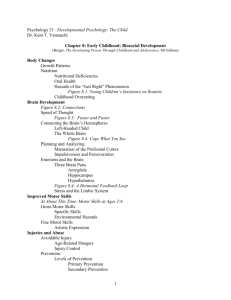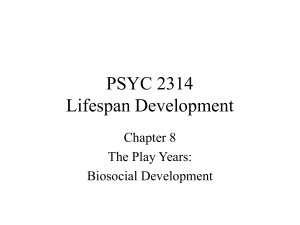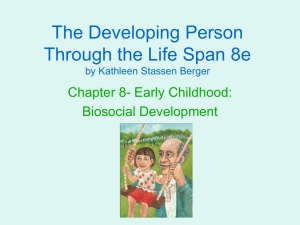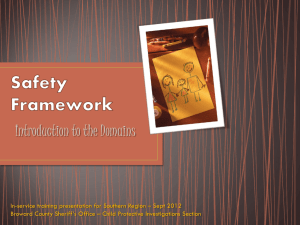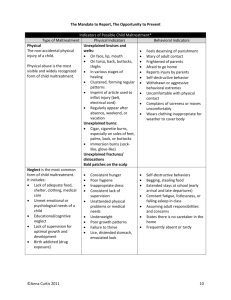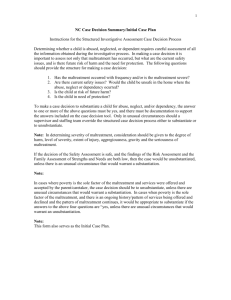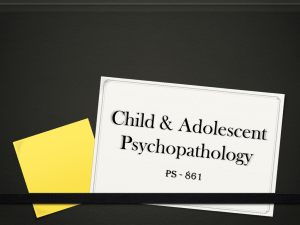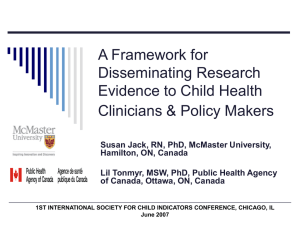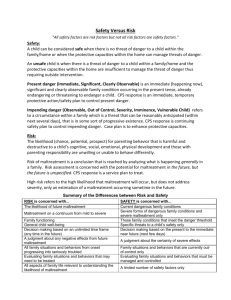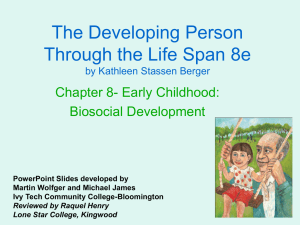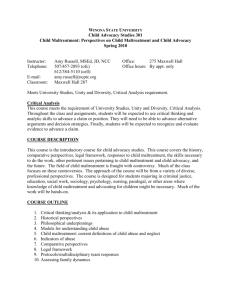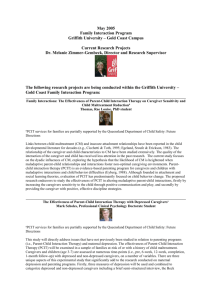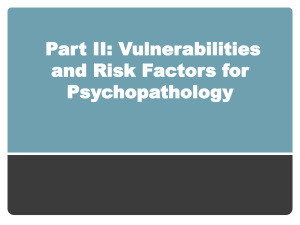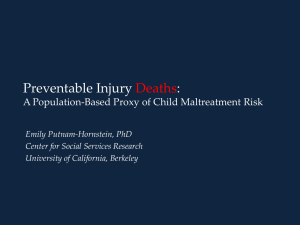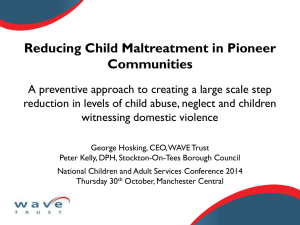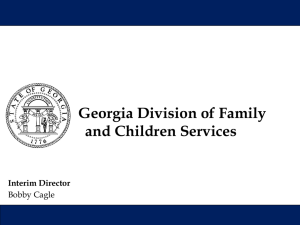to view the presentation. - Together We Can Conference
advertisement
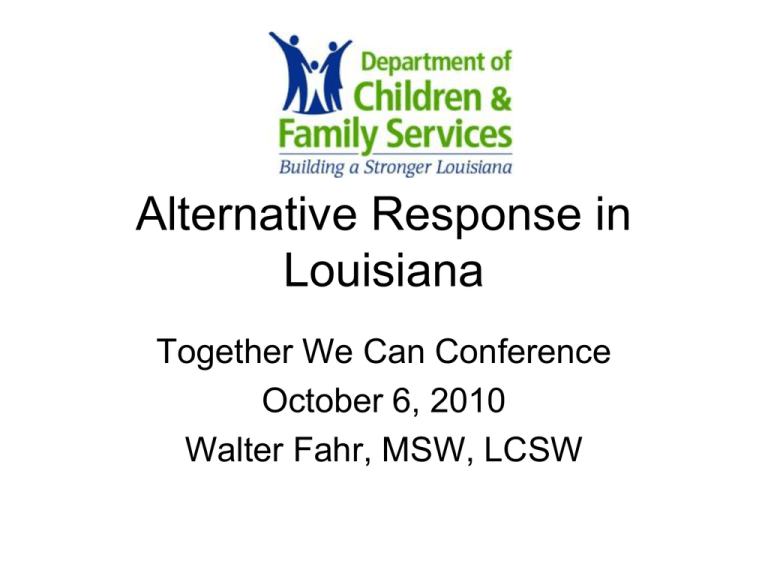
Alternative Response in Louisiana Together We Can Conference October 6, 2010 Walter Fahr, MSW, LCSW Outline • • • • • • • What is Alternative/Differential Response Who is using it Why is it being used-Data What does it look like in Louisiana Key elements to a successful program Engaging Families with AR/DR Solution Focused Questions. Alternative Response Resources • American Humane – http://www.americanhumane.org/protectingchildren/programs/differential-response/ Contributors to this Presentation • All the DCFS staff using AR • Especially the Baton Rouge region AR staff • Kingsley House- New Orleans • Sue Lohrbach Olmsted County, MN • Jerry Patton, SELU • Pat Schene, Senior Fellow AHA Definition of AR • DIFFERENTIAL RESPONSE, ALSO REFERRED TO AS “DUAL TRACK,” “MULTIPLE TRACK,” OR “ALTERNATIVE RESPONSE,” IS AN APPROACH THAT ALLOWS CHILD PROTECTIVE SERVICES TO RESPOND DIFFERENTLY TO ACCEPTED REPORTS OF CHILD ABUSE AND NEGLECT, BASED ON SUCH FACTORS AS THE TYPE AND SEVERITY OF THE ALLEGED MALTREATMENT, NUMBER AND SOURCES OF PREVIOUS REPORTS, AND WILLINGNESS OF THE FAMILY TO PARTICIPATE IN SERVICES-American Humane AR-Pat Schene • DR is a way to serve more of the legitimate reports (screened in) at an earlier stage by engaging families in a non -adversarial process of linking them to needed services • Sets aside fault finding and substantiation decision Why Implement Differential Response?-Pat Schene • The majority of investigations do not result in any services being provided. Since the overwhelming majority of cases are not served through court orders, evidence collection is not always needed • Differential Response allows the system to move more quickly to address safety needs DCFS Definition of AR The family assessment is an alternative response to an investigation of a report of child abuse/neglect. It is a safety focused, family centered and strength-based approach to addressing reports. A family assessment is completed to determine the safety of the child, the risk of future abuse/neglect to identify the family needs and strengths; provide direct services as needed and appropriate; and/or,connect the family to resources in the community. As a strength-based intervention, it draws on the strengths and resources of the family members to address safety and/or risk issues. The process seeks to discover periods of successful family functioning, understanding the factors that made those periods possible, and work to recreate those factors. It assumes that people are best understood within the context of their own environment and when they are allowed to define their own circumstances and capacities. Also, it assumes that families who are supported by kin and community are the most likely to have positive outcomes. DCFS Policy Alternative Response AR IS APPROPRIATE For Children and families who appear to be at lower risk or who present less immediate safety concerns. These families’ circumstances may not warrant a traditional CPS response, but can benefit from some intervention to prevent potential or future maltreatment. Core Elements of AR • • • • Two or more discrete responses to reports of maltreatment that are screened in and accepted Assignment to response pathways is determined by array of factors Original response assignments can be changed Ability of families who receive a noninvestigatory response to accept or refuse to participate in Alternative Response or to Core Elements Continued… • After assessment, services are voluntary for families who receive a non-investigatory response (as long as child safety is not compromised) • Establishment of discrete responses is codified in statute, policy, protocols • No substantiation of alleged maltreatment and services are offered without formal determination that maltreatment has occurred • Use of central registry is dependent upon type Alternative Response in Child Protective Services Common Ground Family Assessment Response Family Interviews Outcomes: Safety, Well-Being & Permanency Investigative Response Finding of Maltreatment Individual Interviews Finding of a Need for Services Child Centered Family Focused Community Based Immediate Response Response 0-5 days Risk Level Proportionally Lower Safety Threats Proportionally Lower Subject to Appeal Practice Model: safety focused solution oriented partnership collaboration Family Conferences SDM Sawyer - Lohrbach Risk Level Proportionally Higher Safety Threats Proportionally Higher Implementation of AR in US • • • • • • • 12 States-Statewide implementation 5 States-Pilot or regional implementation 5 States-Planning AR 2 States- Tribal implementation only 6 States-Other Innovative Response 16 States- No AR Implementation 4 States-Discontinued AR 14 National Data on AR-NCANDS • Child Maltreatment 2008 • AR cases Approximately 8% of total findings from 13 states • 277,947 Children in AR cases(28%) • 715,760 Children with substantiated(valid) findings(72%) • Louisiana had 1308 AR children (11%) versus 10,173 substantiated victims. Article 612(3) of the Louisiana Children’s Code: “In lieu of an investigation, reports of low levels of risk may be assessed promptly through interviews with the family to identify needs and available match to community resources.” History of Alternative Response in Louisiana • 1996-OCS develops AR Task Force • August 1998-AR Pilot in Jefferson Parish • January 1999-AR contract with Kingsley House in Orleans Parish • November 2005-Kingsley House Contract terminated ( Katrina) • January 2007-AR Planning Committee organized • October 2007-AR begins in BR, Covington, and Jefferson Regions • March 2008-AR expands to Thibodaux, Lafayette, Lake Charles regions • May 2008-AR expands to Shreveport, Alexandria, Monroe and New Orleans regions • February 2010-SDM intake implemented in Baton Rouge Region, Ascension and Calcasieu Parishes • June 2010- SDM intake expands statewide Questions still needing answers: Are children whose families participate in the noninvestigation pathway as safe as or safer than children whose families participate in the investigation pathway? How is the non-investigation pathway different from the investigation pathway in terms of family engagement, caseworker practice and services provided? What are the cost and funding implications to the child protection agency of the implementation and maintenance of a differential response approach? Percentage of AR Cases of Accepted Cases October 2007-July 2010 Parish Oct 07-Sep 09 May 2010 June 2010 July 2010 17% 33% 44% Jefferson 20% Orleans 5 Baton Rouge 15 44 38 31 Covington 24 23 35 35 Thibodaux 9 21 36 51 Lafayette 23 7 31 36 Lake Charles 14 34 34 29 Alexandria 16 34 34 33 Shreveport 12 8 26 28 Monroe 11 12 29 33 21% 32% Statewide 11% 35% Solution Focused Questions for Families Based on a presentation by Sue Lohrbach Fahr’s Key to Success in AR • Stakeholder support • Adequate PAF funds. Staging For Success: Assumptions About Families Until proven otherwise, the belief is that all families want to: • Be proud of their children • Have a positive impact on their children • Hear good news about their children and learn what their children are good at • Give their children a good education and a good chance at success • Have a good relationship with their children • Be hopeful about their children Staging for Success: Assumptions About Children & Youth Based on observations and listening, the belief is that all children want to: • Have their families be proud of them • Please their parents and other adults • Be accepted and part of the social group in which they live • Learn new things • Be active and involved in activities with others • Be surprised and surprise others • Voice their opinions and choices • Make choices when given an opportunity Back Pocket Skill Set for AR Workers • • • • • • * * * * * * Scaling Questions Exception Finding Questions Coping Questions Miracle Questions Details & Amplification Goal Focus Building an Invitation List: Amplification • Draw a picture (e.g. genogram, tree…) * on paper * with words * other (include pets) • Who is in your family? * BIG PICTURE * Who else and who else? * Who is missing? * Where do they fit? Downsizing As Needed: Scaling Question • On a scale of 1-10, where 1 is “no way” and 10 is “absolutely”, how willing are you to include everyone in this picture? * If you were to “downsize”, where would you start? * How did you decide? * Pros/Cons? * What might they think? Laying the Groundwork: Children & Youth • Call upon play and pictures in addition to words and stories • Know developmental milestones • Work with parents and caregivers • Work with child/youth’s adult network • Be ready to translate • Be flexible Possibilities: Coping, Scaling, Amplification & Exceptions • What do you think will stack this meeting for success? • How could we make that work? • Who needs to be in the mix of planning? • What else and what else would be helpful? • Given that has been a struggle, what other ideas do you have? • When was there a time when folks got together and things went well? • What might have made the difference? What else? • How did you cope with everything you just described? • What keeps you going? • What is it about you that got you through such a struggle without giving up hope? • On a scale of 1-10, where 1 is “zip” and 10 is “good to go”, how willing are you to give this a try? What would move you one step closer to a 10? Safety: Scaling, Amplification & Coping • On a scale of 1-10, where 1 is “completely stressed” and 10 is “prepared to manage”, how confident are you that you are safe enough in the meeting to fully participate in plan making? • What is currently in place for your number to be that high? • What could we put in place that might increase your confidence/safety by one number? • What/who have you called upon in the past that has been helpful in similar situations? What/who else? • What do you think the impact will be on you when you/they are in the same space together? Impact on children? Others? Openings/Closings: Amplification • What would be your hope for starting out the meeting? • What are the important ways your family begins conversations/gatherings? • How will you know the meeting was successful? The plan workable? • When you think about the decision to be made and developing a plan, what information needs to be at the table to help the family? What else and what else?
